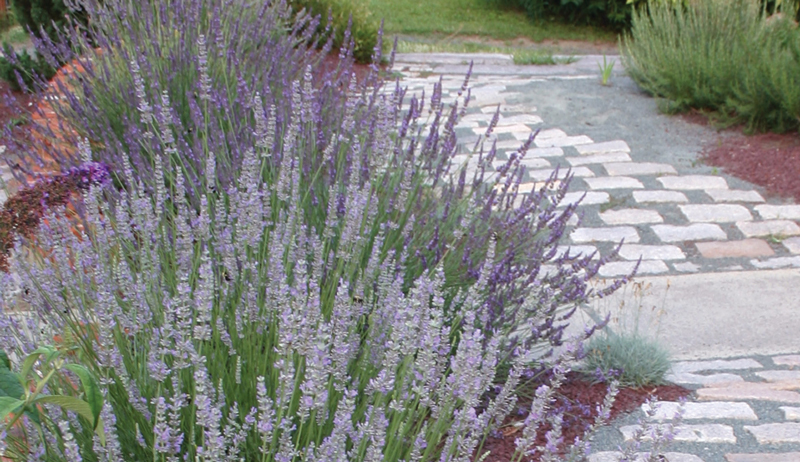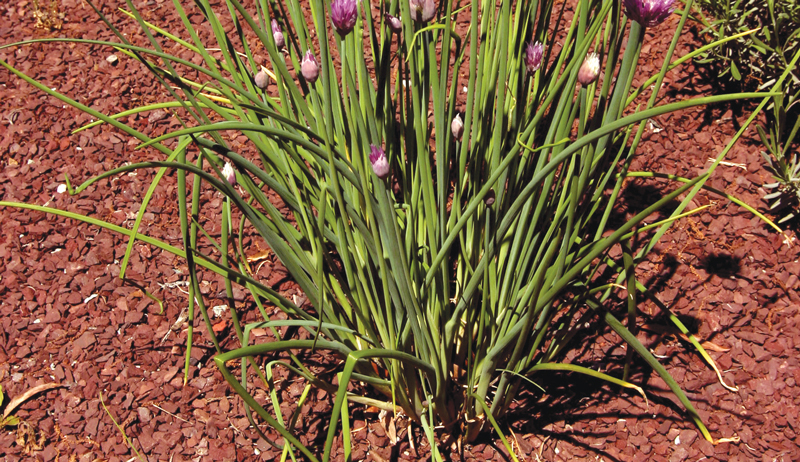
There are lots of thoughts on the benefits of culinary herbs for backyard chickens. Some are based on folklore, some on science. And some is just based on what smells good to a chicken-keeper.
Some culinary herbs are added to feed, spread in the coop or used medicinally. I’m not going to address any of that in this column!
Rather, I’m going to fill you in on what you need to know to successfully grow many of the culinary herbs recommended for chickens.
Culinary Herbs
By culinary herbs, I mean:
- bay laurel
- rosemary
- lavender
- sage
- thyme
- oregano
- marjoram
- tarragon
- parsley
- cilantro
- chervil
- fennel
- dill
- chives

The first two are woody shrubs.
The next six are subshrubs. (This will be important in the section on proper pruning of herbs so you don’t accidentally kill them.)
The next five are biennials. (This will matter in discussion of permanent mulches that save time and money and promote seeding-in).
And the last one is an herbaceous perennial bulb and the only one that can be reliably divided to create more plants. (Plus, you can eat the flowers!).
I won’t be addressing medicinal herbs because they grow in a variety of conditions. And I won’t be addressing herbs such as basil, which need the kind of rich soil found in vegetable gardens. I also won’t be addressing herbs such as the mints and lemon balm that tend to overflow their bounds.
One thing all the 14 culinary herbs listed previously have in common is that they are either native to, or adapted to, Mediterranean conditions. In an eggshell, those conditions are:
- gravelly (or sandy), well-drained soil
- an alkaline pH of about 8
- low organic matter
- low nitrogen level
- high phosphorus level
- full sun
So if you’re living in Central or Southern California, most likely you already have those conditions. That part of California is considered a mediterranean (lowercase ‘m’) region, as are the other parts of the world known for their wines: central Chile, coastal South Africa and southeastern Australia.
Those conditions listed favor wine grapes and culinary herbs. So if you want to do a bang-up job growing the best wine grapes or culinary herbs outside of those five mediterranean (lowercase ‘m’) regions, you’ll have to adjust your soil conditions, mulch choices and pruning practices a bit.
Read more: Check out these 5 herbs your hens will love!
Waste Not Wood Ash
The Mediterranean soils in which our culinary herbs evolved have an alkaline pH of about 8. And they do best at that level in terms of fragrance, flavor and feistiness because that high pH gives them just the right amount of soil nutrients.
If you’re in the eastern half of the U.S. or the Pacific Northwest, your native soils probably have a pH of about 5. A pH of 8 doesn’t sound very far away, but the distance is exponential.
That means if it takes 1 pound of lime to raise your herb garden from 5 to 6, you’ll need 10 pounds to get it from 6 to 7. And 100 pounds to get it from 7 to 8.
Rainfall will dilute that lime by a third each year, so it’s not a one-time thing. But if you or a neighbor heat with wood, you can sustain a proper herb garden pH while safely disposing of your ash each year.
Wood ashes are like lime: They can make nutrients in an acidic soil more available to certain plants and boost microbe populations.
Wood ash has about half the alkaline strength as lime. So if your soil test says to use 10 pounds of lime, use about 20 pounds of wood ash for roughly the same effect. A 5-gallon bucket holds about 15 to 20 pounds of (cool) wood ashes.
It’s dusty and caustic stuff, so wear a bandanna and gloves while spreading it. Because your herb garden is a perennial bed, there is no need to till it in. Rain will dissolve and carry it into the root zone.
And don’t worry if you don’t have just the right amount of ash. It’s hard to overdo. As long as you keep above a pH of 7, herbs grown for chickens will do well.
Fine-tune the Fertility
These culinary herbs we’re growing for chickens evolved in dry conditions—not as dry as a desert but pretty close. In low-rainfall regions such as the Mediterranean, you’ll find much less organic matter and much less nitrogen in the soil than you will in high rainfall regions such as the Pacific Northwest and the eastern half of the U.S.
Why? Less rainfall equals less plant matter equals less nitrogen-heavy organic matter to decompose in the soil. And Mediterranean natives are adapted to that.
So my advice for prepping or maintaining culinary herb gardens: Don’t add nitrogen fertilizer, and don’t add organic matter. When I’ve done taste tests with chefs and other foodies, they could tell the difference.
Herbs grown fat and fast on rich soil have a diluted flavor and fragrance that will be less appealing to your chickens. Herbs grown more slowly on lean soil have a fervent flavor and fragrance.
So save the organic matter for your vegetable garden. And only add organic fertilizers to your new herb bed with little or no nitrogen such as bone meal and green sand for the best flavors.
Then don’t add anymore in the future. A good application up front will last decades.
Read more: Here are some good midsummer fertilizers for container gardens.
Gravel as a Soil Amendment
If you already have well-drained soil that’s sandy and/or gravelly, skip this section. But if you have soil that’s loamy or especially if your soil is clay-based, listen-up.
Culinary herbs want soil that drains quickly and doesn’t hold moisture forever.
To get my clay-loam soils to drain faster, I till the herb bed up. This is a good time to also add organic phosphorus, potassium and lime or wood ash. Then I spread a 2-inch layer of inexpensive 3⁄8-inch driveway gravel over it.
With a good gravel rake, I quickly work that gravel into the top couple inches of soil, so that the top 4 inches of ground is roughly 50-50 soil and gravel. The gravel is a permanent soil amendment that allows rainwater to drain faster.
Pretty & Permanent
I know that when I mention gravel mulch, many people think of some bleak landscape of surly cactus and dirty white stones. Yes, that would be nasty, but that’s not what I have in mind.
In an effort to remake soil conditions that would somewhat resemble Mediterranean herbs’ native ground, I apply a 2-inch layer of a lovely purple-colored gravel as a permanent mulch. (One of my garden clients has advised me to say “merlot-colored” or “cabernet-colored gravel” instead!)
This strategy has paid off in several ways.
- The gravel doesn’t absorb rainwater, so herbs get the dry-ish soil they prefer.
- It doesn’t break down like organic mulch so the soil stays lean.
- The gravel did cost more up front than organic mulch, but I and my clients have herb beds that are up to 15 or 20 years old and have not needed the annual expense of being re-mulched.
- That’s also a great labor savings over a couple decades of not spreading mulch in herb beds.
- A 2-inch layer of gravel does a much better job than organic mulch in keeping most (but not all) annual weeds of the eastern U.S. such as henbit, chickweed and crabgrass from germinating.
- That layer of gravel also favors re-seeding by some Mediterranean herbs and perennial flowers that don’t re-seed into organic mulch.
- The first thing gardeners notice is that like a dark carpet, the dark color hides any debris better than light-colored gravel would. And the purple—sorry—cabernet color offsets the green, gray and blue foliage of these Mediterranean natives in a magically beautiful way.
Read more: These 7 materials make great garden mulch!
But Why?
Why the difference with weeds?
My theory is that perhaps the seeds of Mediterranean herbs need to fall down into that darkness between gravels to germinate. And conversely, the small, windblown annual weed seeds land on a 2-inch layer of gravel and flow down through the voids where they don’t get enough sunlight to germinate.
On an organic mulch of bark, the weed seeds land on the surface, get plenty of light and germinate enthusiastically.
But the key here is to apply the mulch at least 2 inches deep to get that benefit. Don’t skimp. I put a few 2-inch thick bricks in the bed as a temporary gauge while spreading the mulch.
For a 5-by-30-foot herb bed (150 square feet), you’ll need 1 cubic yard of pretty gravel for mulch (or cheap gravel for a soil amendment). One caveat: Only use gravel mulch in beds that don’t get covered with tree leaves in the fall. It’s very difficult to extract the leaves without making a mess of the gravel mulch.
At the stone yard, gravel often comes in two sizes: 3⁄4-inch or 3⁄8-inch. I favor the smaller 3⁄8-inch gravel, but the larger gravel will work.
You may not be able to buy cabernet-colored gravel locally, but any dark or medium-dark color will do. Anything light-colored will look good the first day and then look as dirty as a white carpet in a house full of dogs and boys after that.
Herbal ‘aircuts
Frank’s Pruning Rule No. 1 for Reducing Pruning Anxiety: Recognize that all plants evolved being grazed on. Each plant expects to be whacked back by aesthetically indifferent herbivores such as cows, horses or hippos.
After a few million years of grazing, plants are ready for us clumsy gardeners.
Growing herbs for your chickens helps you get over pruning anxiety. Unlike most evergreens, they provide immediate positive reinforcement: They smell good, and you can do something delightful with the clippings right away.
You sure can’t toss holly leaves into the soup with any success.
And herb trimmings have another use. I store clippings of six herbs—lavender, sage, rosemary, thyme, marjoram and oregano—in a container with a tight-fitting lid. The resins that give fragrance and flavor to these somewhat woody herbs also make them flammable when dry.
A small handful makes great kindling for fires in the winter.
These six herbs are actually called subshrubs. Their stems are woody at the base but herbaceous at the tips.
Don’t clip them all the way back to the base of the branches unless you want to kill them. Leave at least four or five nodes of foliage on the herbaceous part of the branch if you want them to leaf out.
If you want herbs grown for your chickens to look bushy and full, shear the foliage back only by half with hedge clippers or hand pruners. Otherwise, they’ll get leggy and open.
Spring and early summer pruning suit these six plants best. Like many culinary herbs, they evolved in the mild winters of the Mediterranean. They simply don’t know how to go dormant in cool weather.
Hard winter pruning that works well for most perennials only stimulates culinary herbs to make new growth on warmish winter days—new growth that can be killed by the next cold front. But cutting a few snips of herbs for the chickens or the kitchen (or both) in winter won’t hurt.
Other perennial herbs such as chives benefit more from division than from pruning. Biennial herbs such as parsley, cilantro, fennel and dill also don’t need pruning and can be allowed to go to seed to sow the next generation.
So hopefully the aromatherapy has reduced your pruning anxiety. But if not, I bet thoughts of a tasty dinner and happy chickens will.
This article originally appeared in the November/December 2020 issue of Chickens magazine.




